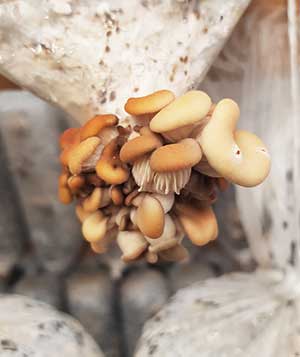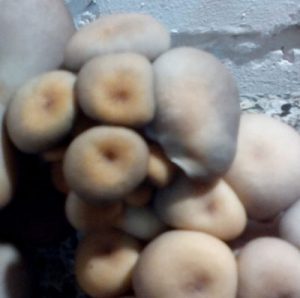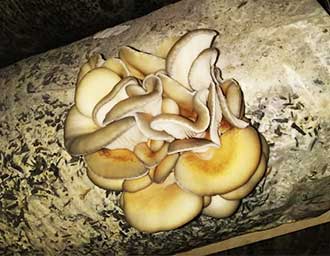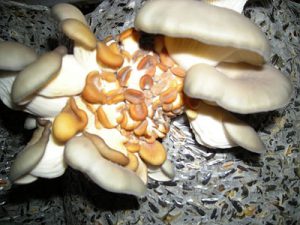Bacteriosis on oyster mushrooms is much less common than on button mushrooms.
The word "bacteriosis" is used in Russian, it is the same as Brown blotch disease.
Its manifestations depend on what type of Pseudomonas bacteria causes the disease.
However, Russian-speaking mushroom growers use the word “bacteriosis” regardless of whether or not there is a pathogen there. Yellow, wet oyster mushrooms or pins - all this will be “bacteriosis”.
 Most often, these are spots of various shapes on the fruiting bodies, ranging from beige to rusty brown, mucilaginous over time, and with an unpleasant odor. See the photo in this article.
Most often, these are spots of various shapes on the fruiting bodies, ranging from beige to rusty brown, mucilaginous over time, and with an unpleasant odor. See the photo in this article.
Please note that the spots do not have clearly defined edges. When the disease occurs, lysis (dissolution) of cells occurs under the influence of microorganisms.
But much more often the disease occurs after exposure to climate change. That is, the yellowing and death of oyster mushrooms does not occur due to disease, but vice versa:
In this case, it is not necessary to fight bacteriosis as such, but to improve the microclimate in the chamber
By the way, the temperature comfortable for the reproduction of pseudomonads is about 17 degrees and above. And this disease hits those enterprises that operate in the summer.
And the yellowing of mushrooms and the death of primordia, which mushroom growers call “infection” and “bacteriosis,” most often occur in winter and at low temperatures.
Red, rusty, red-brown dots or small brown spots on the skin of the mushroom with clear edges are most likely NOT bacteriosis.
These spots appear:
Interestingly, diseased mushrooms often have small dots of a darker brown color on their cap.
They look like punctures. These are traces of insects or their larvae.
When affected by bacteriosis, parasites are common. They are the ones who carry pseudomonas on their paws.
Quite often, bacteria, including pseudomonas, multiply in the humidifier and film air ducts. Therefore, change film air ducts at least once every two seasons and be sure to wash your humidifier periodically.

The appearance of damaged, slimy fruits means problems with the substrate itself. In these cases, it is waterlogged and has a large amount of free water.
Bacteria develop in such a block. Primordia feed on a solution containing bacteria and become ill with bacteriosis.
It is useless to treat such oyster mushrooms; it is necessary to pay attention to the preparation of the substrate.
Diseased bunches should be torn off and disposed of.
There is no point in treating mushrooms with any chemicals.
You won't save sick mushrooms, but you can burn or poison good mushrooms that grow nearby.
With severe bacterial damage, the substrate itself becomes overgrown with spots, smells bad and does not bear fruit at all.
If the infection is local, in most cases, only under the film, then primordia are formed, but are often affected by the disease.
If your substrate is at optimal humidity, bacteria may appear if the substrate is not cooled properly during incubation. With hydrothermal treatment, a treatment is often carried out, which under optimal conditions gives a good overgrowth of the block, without problems.

But when free water is released under the film, bacteria rapidly multiply in the subfilm layer if the heat treatment is not done entirely correctly. It’s just that with normal distribution of moisture throughout the substrate, bacteria do not receive optimal conditions for themselves. But in the case of liquid movement under the film, the humidity there reaches 100%. Pseudomonas spread very quickly, since it is warm and humid between the substrate and the film, and infect the primordia.
During sudden cooling, part of the mycelium can grow between the substrate and the film, forming a stroma.
If the disease periodically appears on the caps, try adding calcium chloride salt to the substrate.
Learn more about the method of adding calcium chloride.
Much more often, secondary infections are mistaken for bacteriosis, which can be either fungal or bacterial (which is what gives the mucous, foul-smelling, rotting mass of fruiting bodies).

Infections such as those in the photo develop on drusen that died earlier due to deficiencies in the operation of microclimatic equipment.
In this case, after the death of the main drusen, small growths begin to develop from the same hole and outstrip the dead fungi in growth.
One gets the impression that only part of the bunch died, but in fact it was two or even three clusters of different ages.
Growing primordia die mainly due to the water film of condensation.
At the same time, they cannot evaporate moisture from their surface. Therefore, the dead mushroom becomes watery and, decomposing, begins to rot.
Almost 100% of the death of oyster mushrooms occurs not due to any diseases, but due to jumps in microclimatic parameters or temporary shutdown of the ventilation system.
Quite often in winter, when the street air is too dry, mushrooms turn yellow even with relatively optimal humidity in the growing chamber.
In other words, the humidity in the chamber may even be below normal - this is evidenced by the fact that the very edge of the mushroom cap is bent down. And at the moment the humidifier starts up, the humidity rises so rapidly that it creates real “wetness” - the air remains dry, but there is droplet moisture in it. Such “dances” with turning the humidifier on/off always lead to defective fruiting bodies.
Therefore, I never tire of insisting: “The humidifier must work constantly!”
Read more in this article.
